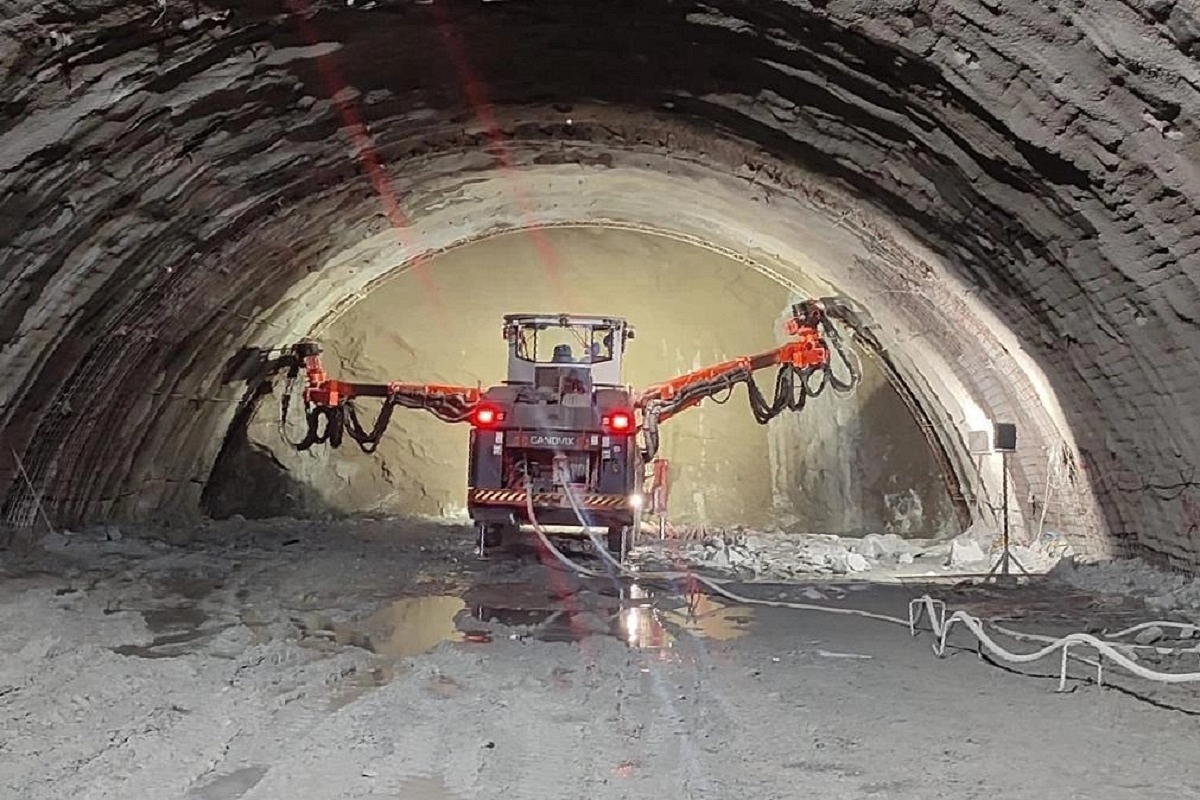Infrastructure
Rishikesh To Karnaprayag: Indian Railways Building 17 Tunnels And 35 Bridges To Cut Travel Time By Half
- Aiming to provide easy access to the pilgrimage centres, the upcoming new rail link will also have 35 bridges across the river Ganga and Alaknanda in Uttarakhand.

Tunnelling work on the rail line.
Using drill and blast method, 17 tunnels are coming up in the 125 km long rail line between Rishikesh and Karnaprayag.
This will facilitate train movement in the hilly terrain reducing the travel time between the two points from six hours to less than three hours.
With the total tunnelling length of 102 km, the train journey is slated to be mostly inside tunnels while 12 stations are being constructed outside the tunnels in the Rs 16,216 crore project.
Since the hilly state is situated near the China border, the project assumes strategic importance with all possible steps being undertaken to execute it at a faster pace.
We are working round the clock in two shifts to complete the project in time, said an engineer at the site of a 21-metre width main tunnel.
Here triple tracks would be laid, said the site engineer and added though machines have come from Germany, Sweden and Italy, all these are operated by trained Indian staff.
While double and triple tracks are being laid at the main tunnels near stations, all tunnels are equipped with escape passages for emergencies.
Faced with a challenging situation, over 7,000 strong workforce is engaged on the rail project to connect important towns like Devprayag, Srinagar, Rudraprayag, Gauchar and Karnaprayag through five districts of Dehradun, Tehri Garhwal, Pauri Garhwal, Rudraprayag and Chamoli.
We are using state-of-the-art machinery to save the cost and complete the project in time, said Rail Vikas Nigam Limited (RVNL) chief project manager Ajit Singh Yadav.
Keeping the earthquake zone in mind, the entire project is being executed to make it quake proof, said Yadav.
RVNL, the railways PSU, has been given the responsibility to execute the important project.
Aiming to provide easy access to the pilgrimage centres, the upcoming new rail link will also have 35 bridges across the river Ganga and Alaknanda in Uttarakhand.
According to the railways, the new broad gauge (BG) railway line between Rishikesh and Karnaprayag is a very important development project in Uttarakhand.
The objective of providing rail link between Rishikesh and Karnaprayag is for facilitating faster movement of pilgrimages, connecting new trade centres, development of backward areas and to serve the population living in the area.
Yadav said that it is expected that such a link will result in a considerable reduction in travel time and cost. This rail link will provide opportunities for industrial development, cottage industry in the area, boost the economy and tourism prospects in the state.
RVNL was entrusted with the implementation of this prestigious project in September 2011 by the Ministry of Railway. Based on earlier studies, the Rishikesh-Karnaprayag New BG Rail line was sanctioned by the Ministry of Railway in 2010-11 with an abstract project cost of Rs 4,295.3 crore. Detailed estimate of Rs 16,216.31 crore has been sanctioned by the board in November 2016.
Final Location Survey (FLS): Considering the topographical constraints and challenges, FLS made use of latest technology and took the benefit of the expertise of international consultants, institutes of repute and eminent experts in the fields of tunnelling, bridges, railway etc, at the planning stage itself.
FLS consultancy contract has been awarded to Geodata India Private Limited.
In view of the importance of the project, the work of proof consultancy was given to IIT-Roorkee, a premier institute of repute in the country with Director, IIT Roorkee heading the team.
The consultant M/s Geodata has completed the alignment survey work in three stages, consisting stage-I, stage-II and stage-III. Stage-I is creation of digital elevation model of the terrain of project corridor and design and study of different alignment options; stage-I is geological survey along the alignment approved in stage-I and consequent refinement of the alignment; and stage-III is detailed geological survey, geo-physical survey along alignment refined in stage-II, further refinement wherever necessary and staking of the final alignment in the field.
According to the site engineer at Gauchar side tunnel, In order to overcome constraints of accessibility imposed by rugged topography and to reduce the time frame for the FLS work, state of the art surveying technique based on satellite imagery was used.
The construction of railway lines in rugged Himalayan topography with complex geology will pose risks/uncertainties and technical challenges which will demand necessary safeguards at the initial design stage itself to minimise risks and difficulties later during construction and operation stages.
With these considerations, RVNL appointed a committee of experts of international repute in the field of railway line construction in hilly areas which carried out field visits and gave its recommendations which were incorporated in the selection of alignment.
Introducing ElectionsHQ + 50 Ground Reports Project
The 2024 elections might seem easy to guess, but there are some important questions that shouldn't be missed.
Do freebies still sway voters? Do people prioritise infrastructure when voting? How will Punjab vote?
The answers to these questions provide great insights into where we, as a country, are headed in the years to come.
Swarajya is starting a project with an aim to do 50 solid ground stories and a smart commentary service on WhatsApp, a one-of-a-kind. We'd love your support during this election season.
Click below to contribute.
Latest